Seasonal and Spatial Variations of Atmospheric Ammonia in the Urban and Suburban Environments of Seoul, Korea
Abstract
:1. Introduction
2. Experimental Setup and Methods
2.1. Site Description
2.2. Sample Collection and Lab Preparation
2.3. Passive Sampler
2.4. Annular Denuder
2.5. Qualitative and Quantitative Analysis
3. Results and Discussion
3.1. Seasonal Variation in Ammonia Concentration
3.2. Spatial Distribution of Ammonia Concentration
3.3. Correlation between Ammonia Concentration and Temperature
3.4. Habitation and Livestock Region Analysis
4. Conclusions
Supplementary Materials
Author Contributions
Funding
Data Availability Statement
Acknowledgments
Conflicts of Interest
References
- Pio, C.A.; Nunes, T.V.; Leal, R.M. Kinetic and thermodynamic behavior of volatile ammonium compounds in industrial and marine atmospheres. Atmospheric Environment. Part A Gen. Top. 1992, 26, 505–512. [Google Scholar] [CrossRef]
- Huang, R.-J.; Duan, J.; Li, Y.; Chen, Q.; Chen, Y.; Tang, M.; Yang, L.; Ni, H.; Lin, C.; Xu, W.; et al. Effects of NH3 and alkaline metals on the formation of particulate sulfate and nitrate in wintertime Beijing. Sci. Total Environ. 2020, 717, 137190. [Google Scholar] [CrossRef]
- Budavari, S. The Merck Index: An Encyclopedia of Chemicals, Drugs, and Biologicals, 12th ed.; Merck: Rahway, NJ, USA, 1996. [Google Scholar]
- Pinder, R.W.; Gilliland, A.B.; Dennis, R.L. Environmental impact of atmospheric NH3emissions under present and future conditions in the eastern United States. Geophys. Res. Lett. 2008, 35. [Google Scholar] [CrossRef]
- Haber, F. The Haber Process. Nature 1923, 111, 101–102. [Google Scholar]
- Paulot, F.; Jacob, D.J.; Pinder, R.W.; Bash, J.O.; Travis, K.; Henze, D.K. Ammonia emissions in the United States, European Union, and China derived by high-resolution inversion of ammonium wet deposition data: Interpretation with a new agricultural emissions inventory (MASAGE_NH3). J. Geophys. Res. Atmos. 2014, 119, 4343–4364. [Google Scholar] [CrossRef]
- Nelson, A.R.L.E.; Ravichandran, K.; Antony, U. The impact of the Green Revolution on indigenous crops of India. J. Ethn. Foods 2019, 6, 8. [Google Scholar] [CrossRef] [Green Version]
- Randive, K.; Raut, T.; Jawadand, S. An overview of the global fertilizer trends and India’s position in 2020. Miner. Econ. 2021, 34, 371–384. [Google Scholar] [CrossRef]
- Bray, C.; Battye, W.; Aneja, V.; Tong, D.; Lee, P.; Tang, Y. Impact of Wildfires on Atmospheric Ammonia Concentrations in the US: Coupling Satellite and Ground Based Measurements. In Proceedings of the 1st International Electronic Conference on Atmospheric Sciences, Online, 16–31 July 2016; p. 1. [Google Scholar]
- Groenestein, C.; Hutchings, N.; Haenel, H.; Amon, B.; Menzi, H.; Mikkelsen, M.; Misselbrook, T.; van Bruggen, C.; Kupper, T.; Webb, J. Comparison of ammonia emissions related to nitrogen use efficiency of livestock production in Europe. J. Clean. Prod. 2019, 211, 1162–1170. [Google Scholar] [CrossRef]
- Maasikmets, M.; Teinemaa, E.; Kaasik, A.; Kimmel, V. Measurement and analysis of ammonia, hydrogen sulphide and odour emissions from the cattle farming in Estonia. Biosyst. Eng. 2015, 139, 48–59. [Google Scholar] [CrossRef]
- Shi, Z.; Sun, X.; Lu, Y.; Xi, L.; Zhao, X. Emissions of ammonia and hydrogen sulfide from typical dairy barns in central China and major factors influencing the emissions. Sci. Rep. 2019, 9, 13821. [Google Scholar] [CrossRef] [PubMed] [Green Version]
- Van Damme, M.; Clarisse, L.; Whitburn, S.; Hadji-Lazaro, J.; Hurtmans, D.; Clerbaux, C.; Coheur, P.-F. Industrial and agricultural ammonia point sources exposed. Nature 2018, 564, 99–103. [Google Scholar] [CrossRef]
- Elser, M.; El-Haddad, I.; Maasikmets, M.; Bozzetti, C.; Wolf, R.; Ciarelli, G.; Slowik, J.G.; Richter, R.; Teinemaa, E.; Hüglin, C.; et al. High contributions of vehicular emissions to ammonia in three European cities derived from mobile measurements. Atmos. Environ. 2018, 175, 210–220. [Google Scholar] [CrossRef]
- Berner, A.H.; Felix, J.D. Investigating ammonia emissions in a coastal urban airshed using stable isotope techniques. Sci. Total Environ. 2020, 707, 134952. [Google Scholar] [CrossRef]
- Chang, Y.; Zou, Z.; Zhang, Y.; Deng, C.; Hu, J.; Shi, Z.; Dore, A.J.; Collett, J.L. Assessing Contributions of Agricultural and Nonagricultural Emissions to Atmospheric Ammonia in a Chinese Megacity. Environ. Sci. Technol. 2019, 53, 1822–1833. [Google Scholar] [CrossRef] [PubMed]
- Zhou, C.; Zhou, H.; Holsen, T.M.; Hopke, P.K.; Edgerton, E.S.; Schwab, J.J. Ambient Ammonia Concentrations across New York State. J. Geophys. Res. Atmos. 2019, 124, 8287–8302. [Google Scholar] [CrossRef] [Green Version]
- Wang, S.; Nan, J.; Shi, C.; Fu, Q.; Gao, S.; Wang, D.; Cui, H.; Saiz-Lopez, A.; Zhou, B. Atmospheric ammonia and its impacts on regional air quality over the megacity of Shanghai, China. Sci. Rep. 2015, 5, 15842. [Google Scholar] [CrossRef] [PubMed] [Green Version]
- Franklin, D.; Edward, L.L. Ammonia toxicity and adaptive response in marine fishes. Indian J. Geo-Mar. Sci. 2019, 48, 273–279. [Google Scholar]
- Wu, Y.; Gu, B.; Erisman, J.W.; Reis, A.; Fang, Y.; Lu, X.; Zhang, X. PM2.5 pollution is substantially affected by ammonia emissions in China. Environ. Pollut. 2016, 218, 86–94. [Google Scholar] [CrossRef] [Green Version]
- Hwang, J.; Kwon, J.; Yi, H.; Bae, H.-J.; Jang, M.; Kim, N. Association between long-term exposure to air pollutants and cardiopulmonary mortality rates in South Korea. BMC Public Health 2020, 20, 1402. [Google Scholar] [CrossRef] [PubMed]
- Pye, H.; Liao, H.; Wu, S.; Mickley, L.J.; Jacob, D.J.; Henze, D.K.; Seinfeld, J.H. Effect of changes in climate and emissions on future sulfate-nitrate-ammonium aerosol levels in the United States. J. Geophys. Res. Space Phys. 2009, 114. [Google Scholar] [CrossRef]
- Tian, P.; Zhang, L.; Cao, X.; Sun, N.; Mo, X.; Liang, J.; Li, X.; Gao, X.; Zhang, B.; Wang, H. Enhanced Bottom-of-the-Atmosphere Cooling and Atmosphere Heating Efficiency by Mixed-Type Aerosols: A Classification Based on Aerosol No sphericity. J. Atmos. Sci. 2018, 75, 113–124. [Google Scholar] [CrossRef]
- Tevlin, A.G.; Li, Y.; Collett, J.L.; McDuffie, E.E.; Fischer, E.V.; Murphy, J.G. Tall Tower Vertical Profiles and Diurnal Trends of Ammonia in the Colorado Front Range. J. Geophys. Res. Atmos. 2017, 122, 12468. [Google Scholar] [CrossRef]
- Wang, Q.; Zhang, Q.; Ma, Z.; Ge, B.; Xie, C.; Zhou, W.; Zhao, J.; Xu, W.; Du, W.; Fu, P.; et al. Temporal characteristics and vertical distribution of atmospheric ammonia and ammonium in winter in Beijing. Sci. Total Environ. 2019, 681, 226–234. [Google Scholar] [CrossRef]
- Nguyen, D.V.; Sato, H.; Hamada, H.; Yamaguchi, S.; Hiraki, T.; Nakatsubo, R.; Murano, K.; Aikawa, M. Symbolic seasonal variation newly found in atmospheric ammonia concentration in urban area of Japan. Atmos. Environ. 2021, 244, 117943. [Google Scholar] [CrossRef]
- Saraga, D.; Maggos, T.; Sadoun, E.; Fthenou, E.; Hassan, H.; Tsiouri, V.; Karavoltsos, S.; Sakellari, A.; Vasilakos, C.; Kakosimos, K. Chemical Characterization of Indoor and Outdoor Particulate Matter (PM2.5, PM10) in Doha, Qatar. Aerosol Air Qual. Res. 2017, 17, 1156–1168. [Google Scholar] [CrossRef] [Green Version]
- Butler, T.; Vermeylen, F.; Lehmann, C.; Likens, G.; Puchalski, M. Increasing ammonia concentration trends in large regions of the USA derived from the NADP/AMoN network. Atmos. Environ. 2016, 146, 132–140. [Google Scholar] [CrossRef] [Green Version]
- Hayashi, K.; Mano, M.; Ono, K.; Takimoto, T.; Miyata, A. Four-year monitoring of atmospheric ammonia using passive samplers at a single-crop rice paddy field in central Japan. J. Agric. Meteorol. 2013, 69, 229–241. [Google Scholar] [CrossRef] [Green Version]
- Clark, L.P.; Sreekanth, V.; Bekbulat, B.; Baum, M.; Yang, S.; Baylon, P.; Gould, T.R.; Larson, T.V.; Seto, E.Y.W.; Space, C.D.; et al. Developing a Low-Cost Passive Method for Long-Term Average Levels of Light-Absorbing Carbon Air Pollution in Polluted Indoor Environments. Sensors 2020, 20, 3417. [Google Scholar] [CrossRef] [PubMed]
- Zhu, L.; Henze, D.K.; Bash, J.; Cady-Pereira, K.E.; Shephard, M.W.; Luo, M.; Capps, S.L. Sources and Impacts of Atmospheric NH3: Current Understanding and Frontiers for Modeling, Measurements, and Remote Sensing in North America. Curr. Pollut. Rep. 2015, 1, 95–116. [Google Scholar] [CrossRef] [Green Version]
- Volten, H.; Bergwerff, J.B.; Haaima, M.; Lolkema, D.E.; Berkhout, A.J.C.; van der Hoff, G.R.; Potma, C.J.M.; Kruit, R.J.W.; van Pul, W.A.J.; Swart, D.P.J. Two instruments based on differential optical absorption spectroscopy (DOAS) to measure accurate ammonia concentrations in the atmosphere. Atmos. Meas. Tech. 2012, 5, 413–427. [Google Scholar] [CrossRef] [Green Version]
- Manap, H.; Dooly, G.; O’Keeffe, S.; Lewis, E. Ammonia Detection in the UV Region Using an Optical Fiber Sensor; Sensors IEEE: Piscataway, NJ, USA, 2009; pp. 140–145. [Google Scholar]
- Sindhwani, R.; Goyal, P.; Kumar, S.; Kumar, A. Anthropogenic Emission Inventory of Criteria Air Pollutants of an Urban Agglomeration—National Capital Region (NCR), Delhi. Aerosol Air Qual. Res. 2015, 15, 1681–1697. [Google Scholar] [CrossRef] [Green Version]
- Nagpure, A.; Gurjar, B.R.; Martel, J. Human health risks in national capital territory of Delhi due to air pollution. Atmos. Pollut. Res. 2014, 5, 371–380. [Google Scholar] [CrossRef] [Green Version]
- Kim, E.; Kim, B.-U.; Kim, H.C.; Kim, S. Sensitivity of fine particulate matter concentrations in South Korea to regional ammonia emissions in Northeast Asia. Environ. Pollut. 2021, 273, 116428. [Google Scholar] [CrossRef]
- Bauer, S.E.; Koch, D.; Unger, N.; Metzger, S.M.; Shindell, D.T.; Streets, D.G. Nitrate aerosols today and in 2030: A global simulation including aerosols and tropospheric ozone. Atmos. Chem. Phys. Discuss. 2007, 7, 5043–5059. [Google Scholar] [CrossRef] [Green Version]
- Buzek, F.; Čejkova, B.; Hellebrandova, L.; Jackova, I.; Lollek, V.; Lnenickova, Z.; Matolakova, R.; Veselovsky, F. Isotope composition of NH3, NOx and SO2 air pollution in the Moravia-Silesian region, Czech Republic. Atmos. Pollut. Res. 2017, 8, 221–232. [Google Scholar] [CrossRef]
- Liu, L.; Zhang, X.; Xu, W.; Liu, X.; Li, Y.; Lu, X.; Zhang, Y.; Zhang, W. Temporal characteristics of atmospheric ammonia and nitrogen dioxide over China based on emission data, satellite observations and atmospheric transport modeling since 1980. Atmos. Chem. Phys. Discuss. 2017, 17, 9365–9378. [Google Scholar] [CrossRef] [Green Version]
- Shen, J.; Liu, X.; Zhang, Y.; Fangmeier, A.; Goulding, K.; Zhang, F. Atmospheric ammonia, and particulate ammonium from agricultural sources in the North China Plain. Atmos. Environ. 2011, 45, 5033–5041. [Google Scholar] [CrossRef] [Green Version]
- Schrade, S.; Zeyer, K.; Gygax, L.; Emmenegger, L.; Hartung, E.; Keck, M. Ammonia emissions and emission factors of naturally ventilated dairy housing with solid floors and an outdoor exercise area in Switzerland. Atmos. Environ. 2012, 47, 183–194. [Google Scholar] [CrossRef]
- Brouček, J.; Čermák, B. Emission of Harmful Gases from Poultry Farms and Possibilities of Their Reduction. Ekológia 2015, 34, 89–100. [Google Scholar] [CrossRef] [Green Version]
- Day, D.; Chen, X.; Gebhart, K.; Carrico, C.; Schwandner, F.M.; Benedict, K.; Schichtel, B.; Collett, J. Spatial and temporal variability of ammonia and other inorganic aerosol species. Atmos. Environ. 2012, 61, 490–498. [Google Scholar] [CrossRef]
- Thöni, L.; Seitler, E.; Blatter, A.; Neftel, A. A passive sampling method to determine ammonia in ambient air. J. Environ. Monit. 2003, 5, 96–99. [Google Scholar] [CrossRef]
- Namieśnik, J.; Zabiegała, B.; Kot-Wasik, A.; Partyka, M.; Wasik, A. Passive sampling and/or extraction techniques in environmental analysis: A review. Anal. Bioanal. Chem. 2004, 381, 279–301. [Google Scholar] [CrossRef]
- Wilson, S.M.; Serre, M.L. Use of passive samplers to measure atmospheric ammonia levels in a high-density industrial hog farm area of eastern North Carolina. Atmos. Environ. 2007, 41, 6074–6086. [Google Scholar] [CrossRef]
- Puchalski, M.A.; Sather, M.E.; Walker, J.T.; Lehmann, C.M.B.; Gay, D.A.; Mathew, J.; Robarge, W.P. Passive ammonia monitoring in the United States: Comparing three different sampling devices. J. Environ. Monit. 2011, 13, 3156–3167. [Google Scholar] [CrossRef]
- Li, Y.; Thompson, T.M.; Van Damme, M.; Chen, X.; Benedict, K.B.; Shao, Y.; Day, D.; Boris, A.; Sullivan, A.P.; Ham, J.; et al. Temporal and spatial variability of ammonia in urban and agricultural regions of northern Colorado, United States. Atmos. Chem. Phys. 2017, 17, 6197–6213. [Google Scholar] [CrossRef] [Green Version]
- Massman, W. A review of the molecular diffusivities of H2O, CO2, CH4, CO, O3, SO2, NH3, N2O, NO, and NO2 in air, O2 and N2 near STP. Atmos. Environ. 1998, 32, 1111–1127. [Google Scholar] [CrossRef]
- Pan, Y.; Gu, M.; Song, L.; Tian, S.; Wu, D.; Walters, W.W.; Yu, X.; Lü, X.; Ni, X.; Wang, Y.; et al. Systematic low bias of passive samplers in characterizing nitrogen isotopic composition of atmospheric ammonia. Atmos. Res. 2020, 243, 105018. [Google Scholar] [CrossRef]
- Sutton, M.A.; Tang, Y.S.; Miners, B.; Fowler, D. Water, Air and Soil Pollution: Focus; Springer Verlag: Heidelberg, Germany, 2001; pp. 145–156. [Google Scholar]
- Vaittinen, O.; Metsälä, M.; Persijn, S.; Vainio, M.; Halonen, L. Adsorption of ammonia on treated stainless steel and polymer surfaces. Appl. Phys. 2013, 115, 185–196. [Google Scholar] [CrossRef]
- Osada, K.; Ueda, S.; Egashira, T.; Takami, A.; Kaneyasu, N. Measurements of Gaseous NH3 and Particulate NH4+ in the Atmosphere by Fluorescent Detection after Continuous Air–water Droplet Sampling. Aerosol Air Qual. Res. 2011, 11, 170–178. [Google Scholar] [CrossRef] [Green Version]
- Lee, T.; Kreidenweis, S.M.; Collett, J.L. Aerosol ion characteristics during the Big Bend Regional Aerosol and Visibility Observational study. J. Air Waste Manag. Assoc. 2004, 54, 585–592. [Google Scholar] [CrossRef] [PubMed] [Green Version]
- Beem, K.B.; Raja, S.; Schwandner, F.M.; Taylor, C.; Lee, T.; Sullivan, A.P.; Carrico, C.M.; McMeeking, G.; Day, D.; Levin, E.; et al. Deposition of reactive nitrogen during the Rocky Mountain Airborne Nitrogen and Sulfur (RoMANS) study. Environ. Pollut. 2010, 158, 862–872. [Google Scholar] [CrossRef]
- Skoog, D.A.; Holler, F.J.; Nieman Crouch, S.R. Appendix I: Evaluation of Analytical Data. In Principles of Instrumental Analysis, 7th ed.; CENGAGE: Seoul, Korea, 2016. [Google Scholar]
- Tang, Y.S.; Braban, C.F.; Dragosits, U.; Dore, A.J.; Simmons, I.; van Dijk, N.; Poskitt, J.; Pereira, G.D.S.; Keenan, P.O.; Conolly, C.; et al. Drivers for spatial, temporal, and long-term trends in atmospheric ammonia and ammonium in the UK. Atmos. Chem. Phys. Discuss. 2018, 18, 705–733. [Google Scholar] [CrossRef] [Green Version]
- Smith, K.A.; Beckwith, C.P.; Chalmers, A.G.; Jackson, D.R. Nitrate leaching following autumn and winter application of animal manures to grassland. Soil Use Manag. 2006, 18, 428–434. [Google Scholar] [CrossRef]
- Sigurdarson, J.J.; Svane, S.; Karring, H. The molecular processes of urea hydrolysis in relation to ammonia emissions from agriculture. Rev. Environ. Sci. Bio/Technol. 2018, 17, 241–258. [Google Scholar] [CrossRef] [Green Version]
- Ivanova-Peneva, S.G.; Aarnink, A.J.; Verstegen, M.W. Ammonia emissions from organic housing systems with fattening pigs. Biosyst. Eng. 2008, 99, 412–422. [Google Scholar] [CrossRef]
- Webb, J.; Broomfield, M.; Jones, S.; Donovan, B. Ammonia and odor emissions from UK pig farms and nitrogen leaching from outdoor pig production. A Review. Sci. Total Environ. 2014, 470–471, 865–875. [Google Scholar] [CrossRef] [PubMed]
- Rotz, C.A.; Oenema, J. Predicting Management Effects on Ammonia Emissions from Dairy and Beef Farms. Trans. ASABE 2006, 49, 1139–1149. [Google Scholar] [CrossRef]
- Phan, N.-T.; Kim, K.-H.; Shon, Z.-H.; Jeon, E.-C.; Jung, K.; Kim, N.-J. Analysis of ammonia variation in the urban atmosphere. Atmos. Environ. 2013, 65, 177–185. [Google Scholar] [CrossRef]
- Chang, Y.; Zou, Z.; Deng, C.; Huang, K.; Collett, J.L.; Lin, J.; Zhuang, G. The importance of vehicle emissions as a source of atmospheric ammonia in the megacity of Shanghai. Atmos. Chem. Phys. Discuss. 2016, 16, 3577–3594. [Google Scholar] [CrossRef] [Green Version]
- Aarnink, A.; Elzing, A. Dynamic model for ammonia volatilization in housing with partially slatted floors, for fattening pigs. Livest. Prod. Sci. 1998, 53, 153–169. [Google Scholar] [CrossRef]
- Puchalski, M.A.; Rogers, C.M.; Baumgardner, R.; Mishoe, K.P.; Price, G.; Smith, M.J.; Watkins, N.; Lehmann, C.M. A statistical comparison of active and passive ammonia measurements collected at Clean Air Status and Trends Network (CASTNET) sites. Environ. Sci. Process. Impacts 2015, 17, 358–369. [Google Scholar] [CrossRef] [PubMed]
- Huang, X.; Song, Y.; Li, M.; Li, J.; Huo, Q.; Cai, X.; Zhu, T.; Hu, M.; Zhang, H. A high-resolution ammonia emission inventory in China. Glob. Biogeochem. Cycles 2012, 26. [Google Scholar] [CrossRef]
- Sun, K.; Tao, L.; Miller, D.J.; Pan, D.; Golston, L.; Zondlo, M.A.; Griffin, R.J.; Wallace, H.W.; Leong, Y.J.; Yang, M.M.; et al. Vehicle Emissions as an Important Urban Ammonia Source in the United States and China. Environ. Sci. Technol. 2017, 51, 2472–2481. [Google Scholar] [CrossRef] [PubMed]
- Nair, A.; Yu, F. Quantification of Atmospheric Ammonia Concentrations: A Review of Its Measurement and Modeling. Atmosphere 2020, 11, 1092. [Google Scholar] [CrossRef]
- Nnadozie, C.F.; Nkwoada, A.U.; Akagha, C.I. Ammonia Variations in Owerri Metropolis and Ecological Impact. J. Atmos. 2020, 3, 15–22. [Google Scholar]
- Bae, C.; Kim, B.-U.; Kim, H.C.; Yoo, C.; Kim, S. Long-Range Transport Influence on Key Chemical Components of PM2.5 in the Seoul Metropolitan Area, South Korea, during the Years 2012–2016. Atmosphere 2019, 11, 48. [Google Scholar] [CrossRef] [Green Version]
- Guenther, A.B.; Jiang, X.; Heald, C.L.; Sakulyanontvittaya, T.; Duhl, T.; Emmons, L.K.; Wang, X. The Model of Emissions of Gases and Aerosols from Nature version 2.1 (MEGAN2.1): An extended and updated framework for modeling biogenic emissions. Geosci. Model Dev. 2012, 5, 1471–1492. [Google Scholar] [CrossRef] [Green Version]
- Hristov, A.N.; Oh, J.; Firkins, J.L.; Dijkstra, J.; Kebreab, E.; Waghorn, G.; Makkar, H.P.S.; Adesogan, A.T.; Yang, W.; Lee, C.; et al. Special Topics—Mitigation of methane and nitrous oxide emissions from animal operations: I. A review of enteric methane mitigation options. J. Anim. Sci. 2013, 91, 5045–5069. [Google Scholar] [CrossRef] [Green Version]
- Bari, A.; Ferraro, V.; Wilson, L.R.; Luttinger, D.; Husain, L. Measurements of gaseous HONO, HNO3, SO2, HCl, NH3, particulate sulfate and PM2.5 in New York, NY. Atmos. Environ. 2003, 37, 2825–2835. [Google Scholar] [CrossRef]
- Todd, R.W.; Cole, N.A.; Clark, R.N.; Flesch, T.K.; Harper, L.A.; Baek, B.H. Ammonia emissions from a beef cattle feed yard on the southern High Plains. Atmos. Environ. 2008, 42, 6797–6805. [Google Scholar] [CrossRef]
- Rhoades, M.B.; Parker, D.B.; Cole, N.A.; Todd, R.W.; Caraway, E.A.; Auvermann, B.W.; Topliff, D.R.; Schuster, G.L. Continuous Ammonia Emission Measurements from a Commercial Beef Feedyard in Texas. Trans. ASABE 2010, 53, 1823–1831. [Google Scholar] [CrossRef]
- Pedersen, J.; Nyord, T.; Feilberg, A.; Labouriau, R. Analysis of the effect of air temperature on ammonia emission from band application of slurry. Environ. Pollut. 2021, 282, 117055. [Google Scholar] [CrossRef] [PubMed]
- Wang, M.; Kong, W.; Marten, R.; He, X.-C.; Chen, D.; Pfeifer, J.; Heitto, A.; Kontkanen, J.; Dada, L.; Kürten, A.; et al. Rapid growth of new atmospheric particles by nitric acid and ammonia condensation. Nature 2020, 581, 184–189. [Google Scholar] [CrossRef]
- Mohammed-Nour, A.; Al-Sewailem, M.; El-Naggar, A.H. The Influence of Alkalization and Temperature on Ammonia Recovery from Cow Manure and the Chemical Properties of the Effluents. Sustainability 2019, 11, 2441. [Google Scholar] [CrossRef] [Green Version]
- Warner, J.X.; Dickerson, R.R.; Wei, Z.; Strow, L.L.; Wang, Y.; Liang, Q. Increased atmospheric ammonia over the world’s major agricultural areas detected from space. Geophys. Res. Lett. 2017, 44, 2875–2884. [Google Scholar] [CrossRef]
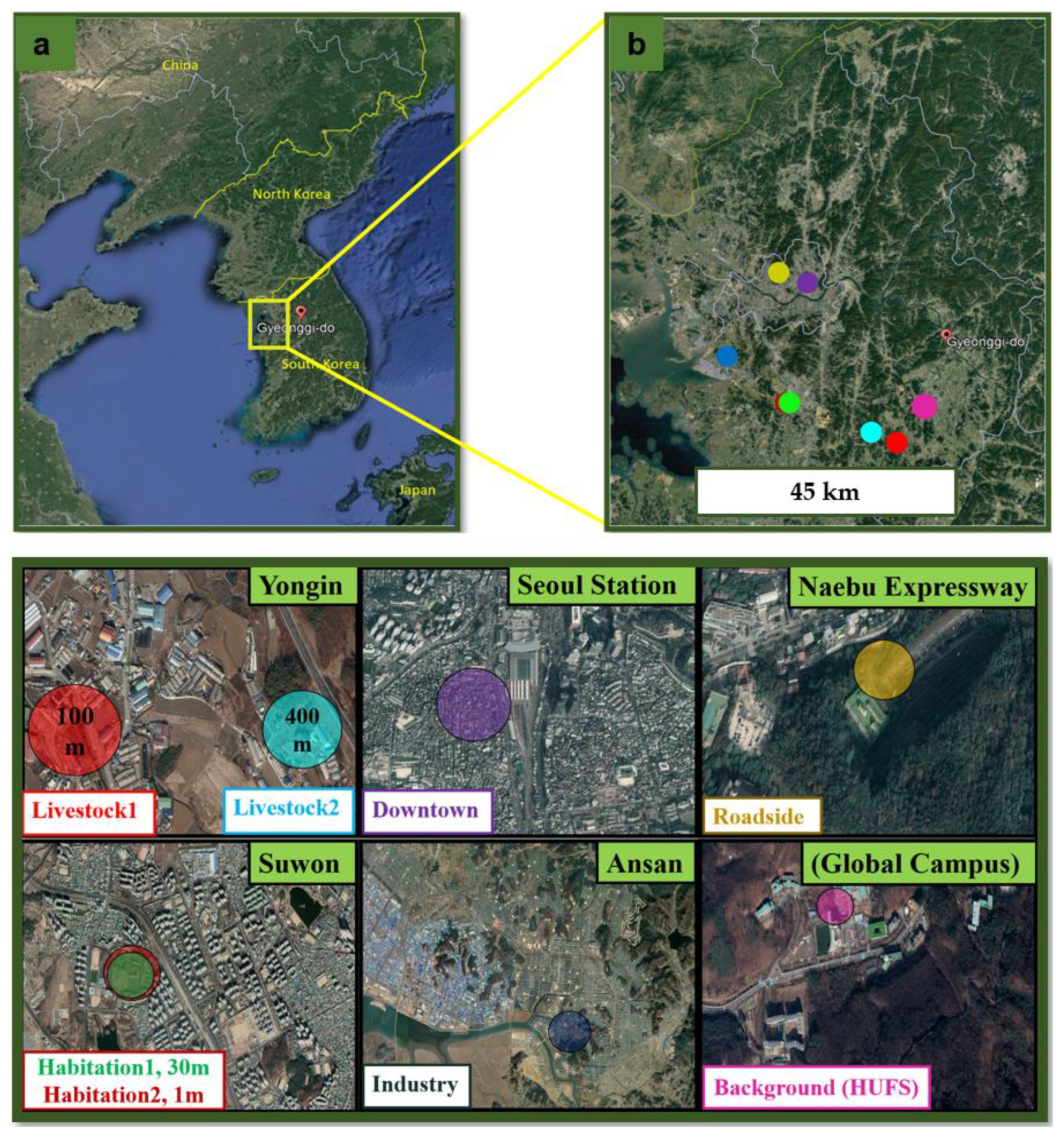
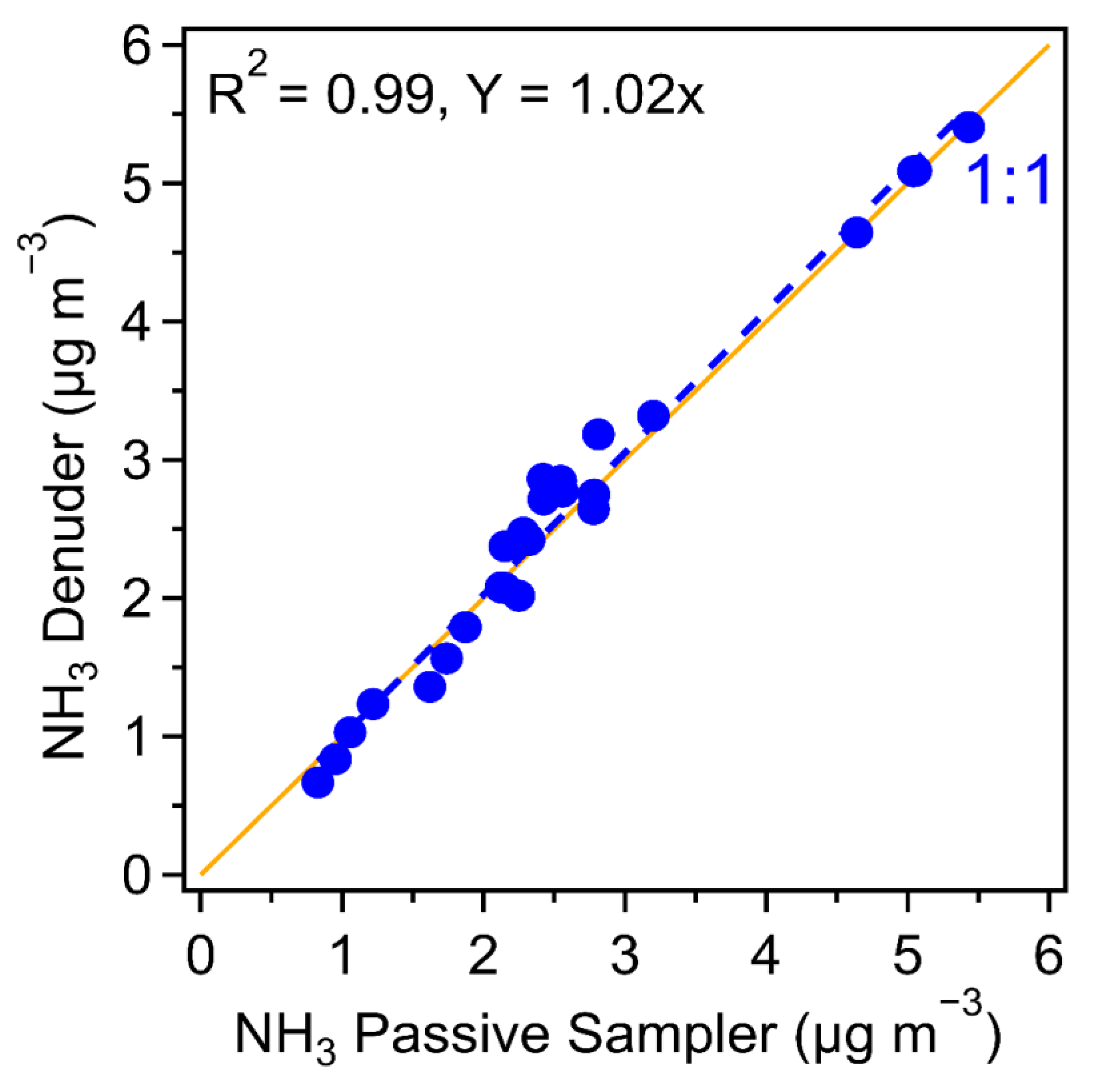

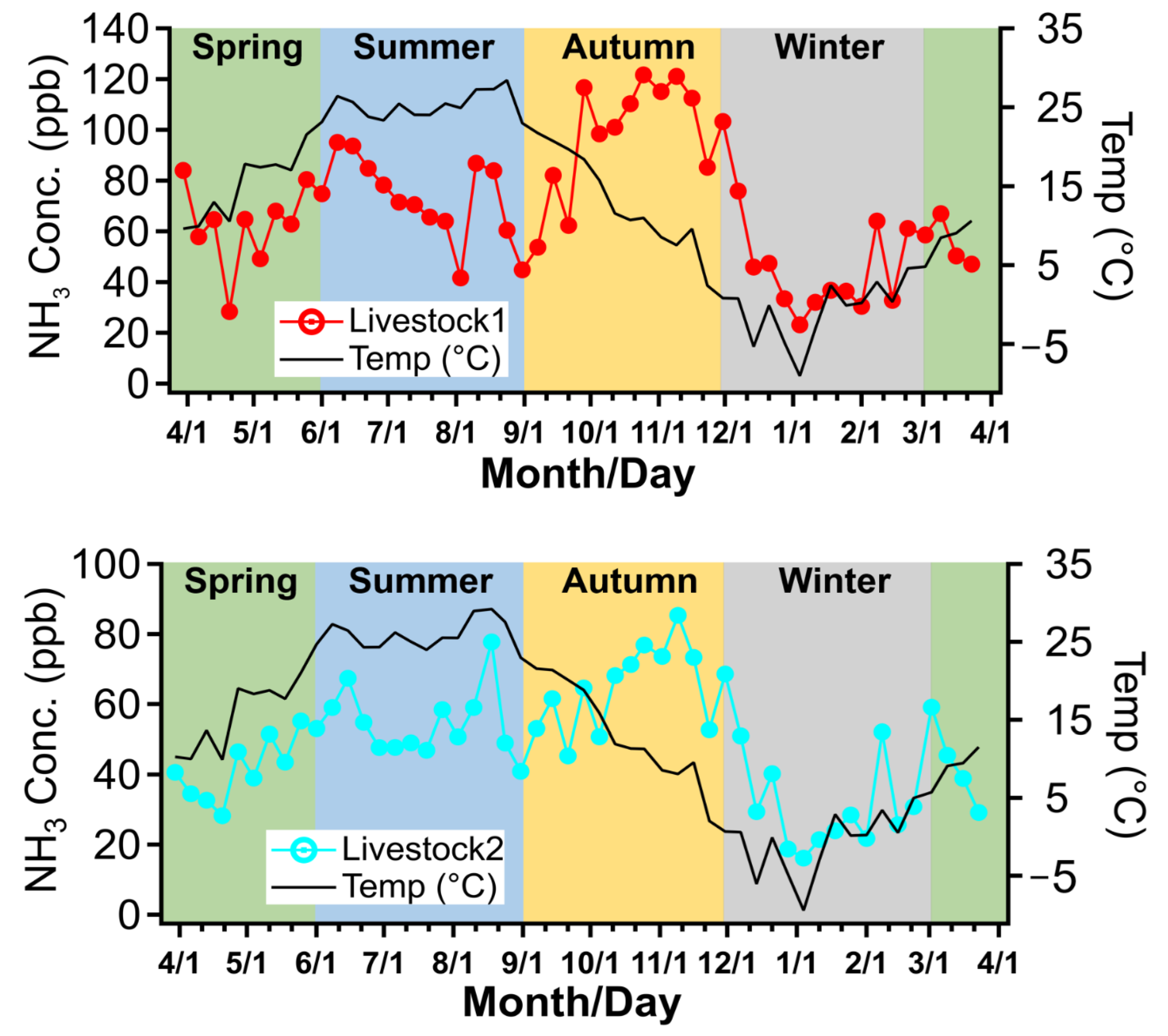
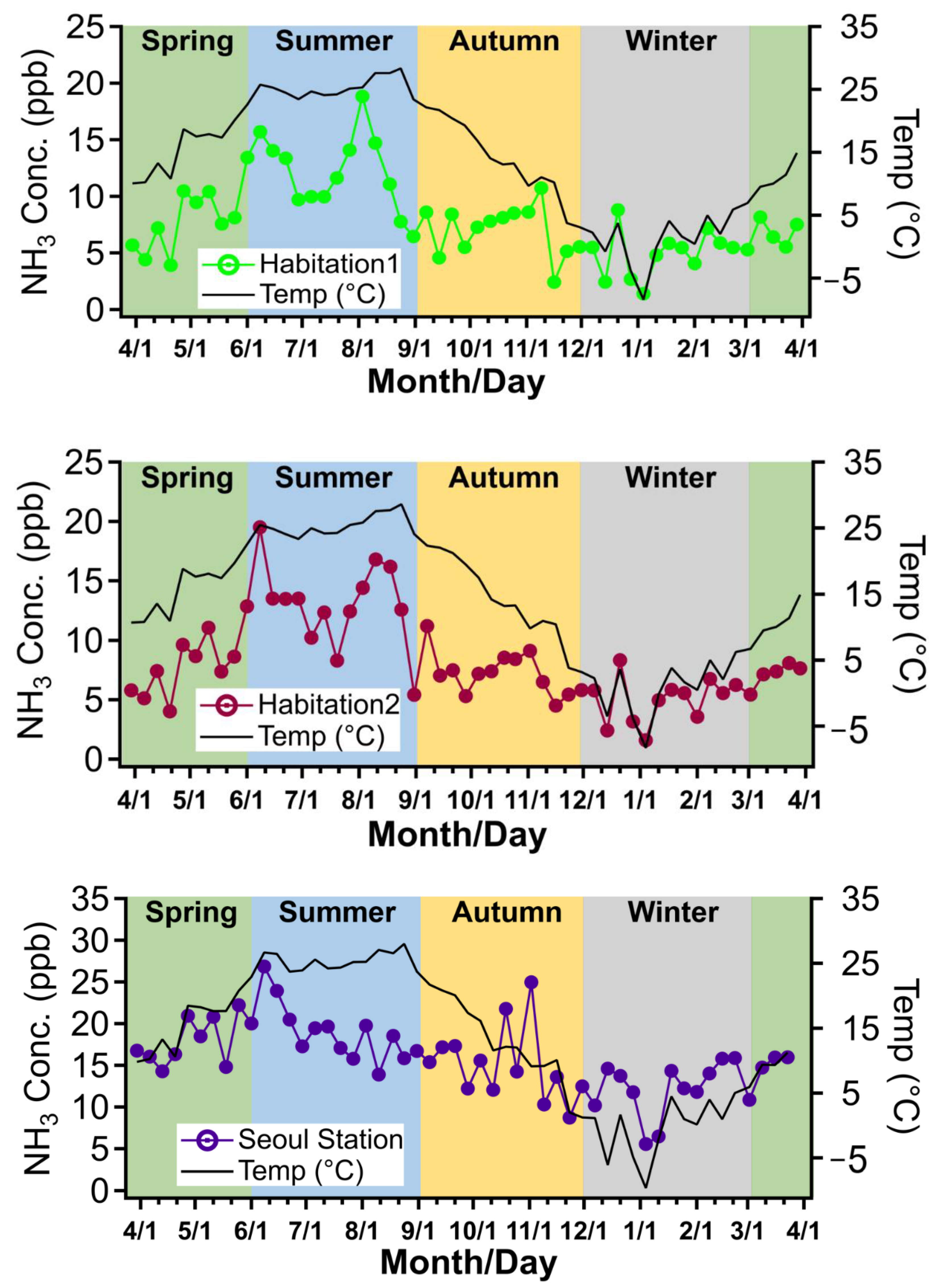
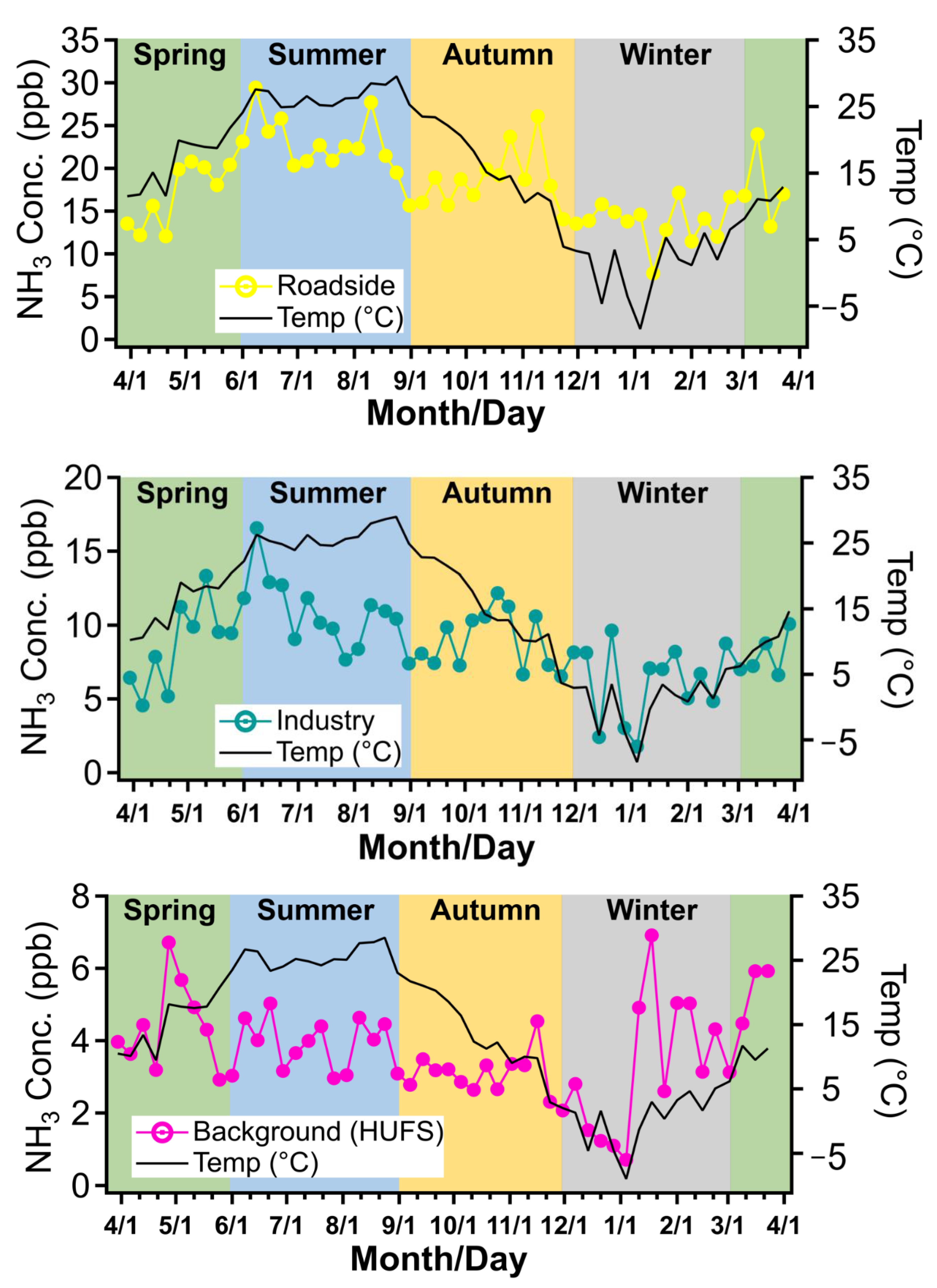
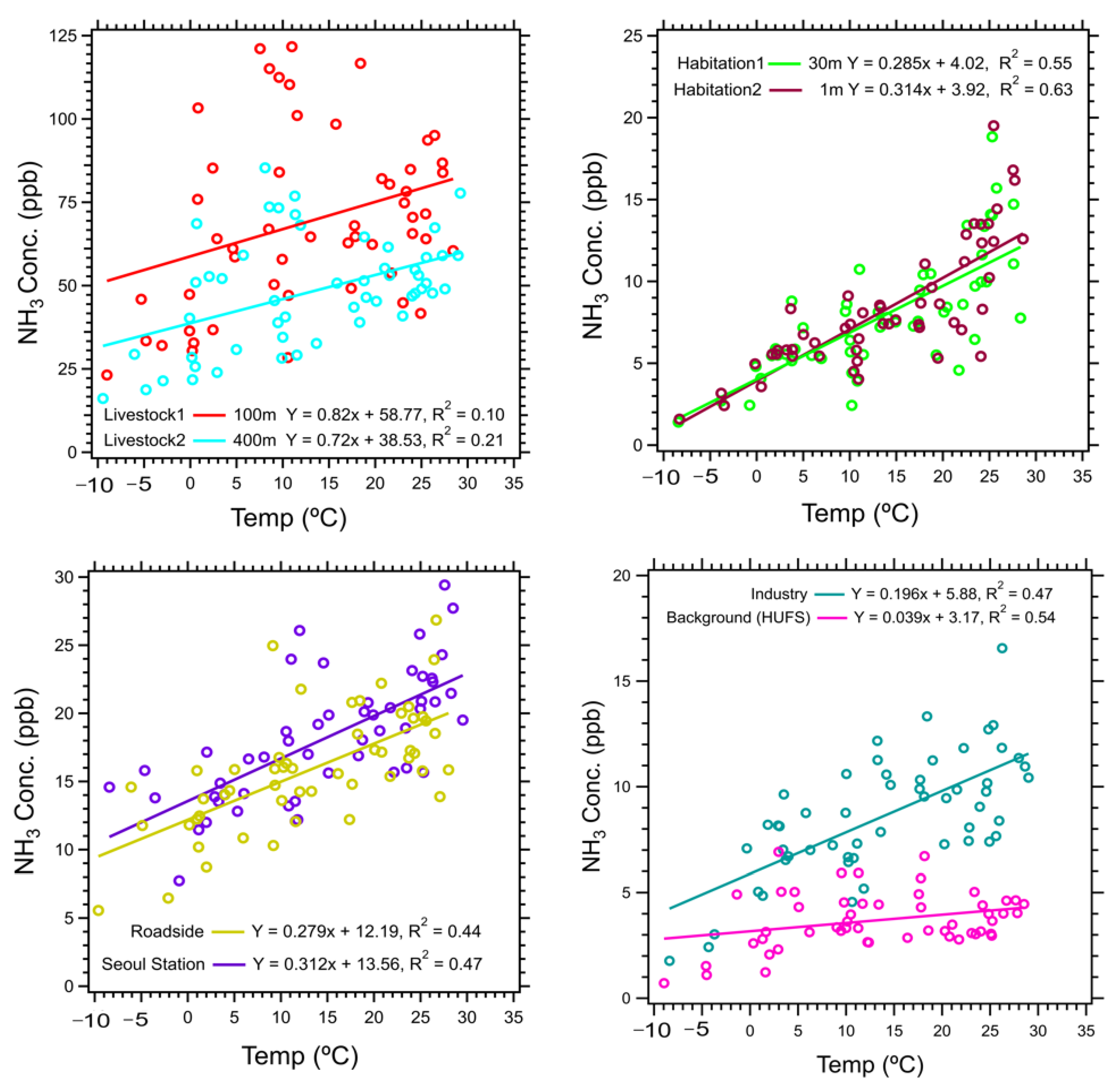
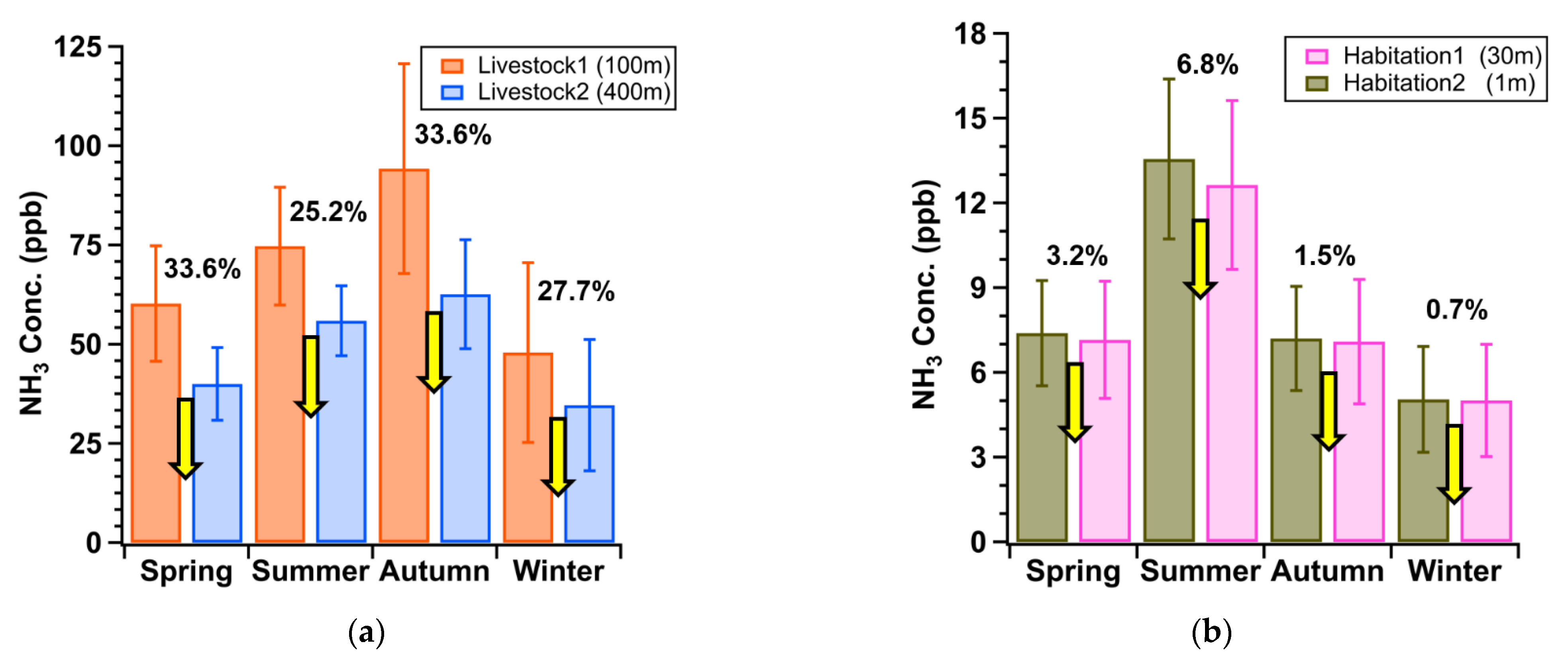
| Site Name | Type | Latitude | Longitude | Sampler Type |
|---|---|---|---|---|
| Livestock 1 (at 100 m distance) | Rural-agricultural | 37.31° | 127.22° | Passive |
| Livestock 2 (at 400 m distance) | Rural-agricultural | 37.31° | 127.22° | Passive |
| Roadside | Suburban | 37.61° | 126.97° | Passive |
| Seoul Station | Urban | 37.55° | 126.98° | Passive |
| Industry | Industrial | 37.27° | 126.86° | Passive |
| Habitation 1 (at 30 m height) | Suburban | 37.30° | 126.96° | Passive |
| Habitation 2 (at 1 m height) | Suburban | 37.30° | 126.96° | Passive |
| Background (HUFS) | Rural | 37.34° | 127.26° | Passive/URG |
| Sites | Average | Standard Deviation |
|---|---|---|
| Livestock 1 | 69.3 | 26.3 |
| Livestock 2 | 48.3 | 16.7 |
| Seoul Station | 18.2 | 4.6 |
| Roadside | 15.9 | 4.3 |
| Habitation 1 | 8.0 | 3.6 |
| Habitation 2 | 8.3 | 3.8 |
| Industry | 8.6 | 2.8 |
| Background (HUFS) | 3.8 | 1.5 |
Publisher’s Note: MDPI stays neutral with regard to jurisdictional claims in published maps and institutional affiliations. |
© 2021 by the authors. Licensee MDPI, Basel, Switzerland. This article is an open access article distributed under the terms and conditions of the Creative Commons Attribution (CC BY) license (https://creativecommons.org/licenses/by/4.0/).
Share and Cite
Singh, R.; Kim, K.; Park, G.; Kang, S.; Park, T.; Ban, J.; Choi, S.; Song, J.; Yu, D.-G.; Woo, J.-H.; et al. Seasonal and Spatial Variations of Atmospheric Ammonia in the Urban and Suburban Environments of Seoul, Korea. Atmosphere 2021, 12, 1607. https://doi.org/10.3390/atmos12121607
Singh R, Kim K, Park G, Kang S, Park T, Ban J, Choi S, Song J, Yu D-G, Woo J-H, et al. Seasonal and Spatial Variations of Atmospheric Ammonia in the Urban and Suburban Environments of Seoul, Korea. Atmosphere. 2021; 12(12):1607. https://doi.org/10.3390/atmos12121607
Chicago/Turabian StyleSingh, Rahul, Kyunghoon Kim, Gyutae Park, Seokwon Kang, Taehyun Park, Jihee Ban, Siyoung Choi, Jeongin Song, Dong-Gil Yu, Jung-Hun Woo, and et al. 2021. "Seasonal and Spatial Variations of Atmospheric Ammonia in the Urban and Suburban Environments of Seoul, Korea" Atmosphere 12, no. 12: 1607. https://doi.org/10.3390/atmos12121607






